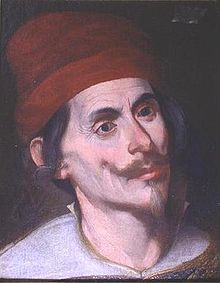Masaniello

Masaniello (actually Tommaso Aniello d'Amalfi ; born June 29, 1620 in Naples , † July 16, 1647 in Naples ) was the main leader of a popular uprising in Naples in 1647. In the course of a hunger and tax revolt, the popular fisherman and trader Masaniello took over power in Naples for ten days. Contemporary witnesses report a mental confusion that set in during this period; on July 16, Masaniello was murdered. To this day he enjoys great popularity in Naples.
Life and course of the uprising
He lived in Naples as a fisherman and fruit dealer. The tax pressure that weighed on the population under Spanish rule had been increased unbearably by the edict published on January 3, 1647 by Viceroy Rodrigo Ponce de León, Duke of Arcos , which placed a high tax on grain and fruit; the promise to abolish it was not kept and the excitement and bitterness of the people were thereby driven to extremes.
When the residents of Naples gathered in large numbers in the streets on July 7th to celebrate a Marian festival, a dispute arose between the fruit traders and tax collectors in the market. Masaniello was bitter against the government because his wife had been punished for secretly evading the tax and shouted into the crowd: “Eat, children, eat; Then we want to abolish the taxes! ”Then the wheelhouses in the city were looted and torn down, the prisons broken down and the viceroy, whose person the insurgents seized, forced to promise the abolition of all taxes on oath.
Meanwhile the Duke of Arcos escaped to the castle during the night and left the city to the rebels. Masaniello now exercised unlimited rule, had many houses of officials and other hated persons destroyed and, having been elected captain-general of the people, knocked back the troops that had come to support the governor.
He sat in court every day in Toledo Square and his death sentences were carried out on the spot. The bandits who flocked to the city to take advantage of the anarchy were driven back or executed. Masaniello was good-natured, with many a noble impulse, and did not seek personal gain. Still, he often appeared vain and complacent.

Cardinal Ascanio Filomarino , the Archbishop of Naples, rode on July 12th as negotiator to the Duke of Arcos - according to tradition, accompanied by more than a hundred thousand people. They signed a treaty that promised the abolition of the new taxes and amnesty and was sworn on July 13th in the Church del Carmine . From then on, “signs of insanity” appeared at Masaniello, and it was therefore easy for the viceroy to induce the people, who moreover had viewed the reconciliation with the viceroy with suspicion, to apostate from what was “marked by God”. When Masaniello appeared in the church del Carmine on July 16 and asked the people to protect him, he was taken to the monastery del Carmine and killed there with shotgun by four bandits Arcos had hired. The next day the repentant people held a great feast for the dead and buried his body in the Church of the Carmine.
Afterlife in literature and music
- Christian Weise processed the subject in 1683 in a drama: Masaniello. Trauerspiel (Ed. By Fritz Martini, Reclam, Stuttgart 1972; Universal Library No. 9327-9329).
- In 1706 Reinhard Keizer composed the opera Die Neapolitan Fischer Outrage or Masaniello furioso .
- August Gottlieb Meißner wrote a historical novel Masaniello in 1784 .
- Masaniello is the main character in the revolutionary play Thomas Aniello by August Fresenius (1818).
- Daniel-François-Esprit Auber used the material for his opera Die Stumme von Portici, composed in 1828 .
- Masaniello plays an important supporting role in Wolfgang Kirchbach's artist novel Salvator Rosa (Leipzig 1880).
- In one of his best-known songs ( “Je so 'Pazzo” ; translated as “I'm crazy” ), the Neapolitan singer Pino Daniele compares himself to the insurgent Masaniello.
literature
- Friedrich Wencker-Wildberg : Uncrowned kings. Attempt of a world history of the adventurer. Das Bergland-Buch, Graz 1934, pp. 298–333
- Gaspare De Caro: AMALFI, Tommaso Aniello d ', detto Masaniello. In: Alberto M. Ghisalberti (Ed.): Dizionario Biografico degli Italiani (DBI). Volume 2: Albicante – Ammannati. Istituto della Enciclopedia Italiana, Rome 1960.
Web links
Individual evidence
- ↑ Die kleine Enzyklopädie , Encyclios-Verlag, Zurich 1950, Volume 2, p. 125.
- ↑ Forconi, quei masanielli d'Italia che ritornano semper (accessed on May 31, 2014)
| personal data | |
|---|---|
| SURNAME | Masaniello |
| ALTERNATIVE NAMES | Amalfi, Tommaso Aniello d '(real name) |
| BRIEF DESCRIPTION | Italian rebel in the uprising in Naples in 1647 |
| DATE OF BIRTH | June 29, 1620 |
| PLACE OF BIRTH | Naples |
| DATE OF DEATH | July 16, 1647 |
| Place of death | Naples |
